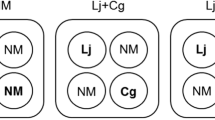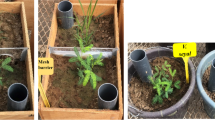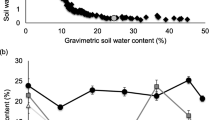Abstract
Effects of elevated atmospheric carbon dioxide (CO2) levels on the production and spread of ectomycorrhizal fungal mycelium from colonised Scots pine roots were investigated. Pinus sylvestris (L.) Karst. seedlings inoculated with either Hebeloma crustuliniforme (Bull:Fr.) Quél. or Paxillus involutus (Fr.) Fr. were grown at either ambient (350 ppm) or elevated (700 ppm) levels of CO2. Mycelial production was measured after 6 weeks in pots, and mycelial spread from inoculated seedlings was studied after 4 months growth in perlite in shallow boxes containing uncolonised bait seedlings. Plant and fungal biomass were analysed, as well as carbon and nitrogen content of seedling shoots. Mycelial biomass production by H. crustuliniforme was significantly greater under elevated CO2 (up to a 3-fold increase was observed). Significantly lower concentrations and total amounts of N were found in plants exposed to elevated CO2.




Similar content being viewed by others
References
Agerer R (2001) Exploration types of ectomycorrhizae. A proposal to classify ectomycorrhizal mycelial systems according to their patterns of differentiation and putative ecological importance. Mycorrhiza 11:107–114
Cairney JWG (1999) Intraspecific physiological variation: implications for understanding functional diversity in ectomycorrhizal fungi. Mycorrhiza 9:125–135
Cairney JWG, Meharg AA (1999) Influences of anthropogenic pollution on mycorrhizal fungal communities. Environ Pollut 106:169–182
Chilvers GA, Gust LW (1982) The development of mycorrhizal populations on pot-grown seedlings of Eucalyptus st-johnii R.T. Bak. New Phytol 90:677–699
Colpaert JV, van Laere A, van Assche JA (1996) Carbon and nitrogen allocation in ectomycorrhizal and non- mycorrhizal Pinus sylvestris L. seedlings. Tree Physiol 16:787–793
Curtis PS, Wang XZ (1998) A meta-analysis of elevated CO2 effects on woody plant mass, form, and physiology. Oecologia 113:299–313
Duddridge JA (1986) The development and ultrastructure of ectomycorrhizas. 3. Compatible and incompatible interactions between Suillus grevillei Klotzsch Sing and 11 species of ectomycorrhizal hosts in vitro in the absence of exogenous carbohydrate. New Phytol 103:457–465
Egli P, Maurer S, Spinnler D, Landolt W, Gunthardt-Georg MS, Korner C (2001) Downward adjustment of carbon fluxes at the biochemical, leaf, and ecosystem scale in beech-spruce model communities exposed to long-term atmospheric CO2 enrichment. Oikos 92:279–290
Finlay RD, Söderström B (1992) Mycorrhiza and carbon flow to the soil. In: Allen M (ed) Mycorrhiza functioning. Chapman and Hall, London, pp 134–160
Finzi AC, Delucia EH, Hamilton JG, Richter DD, Schlesinger WH (2002) The nitrogen budget of a pine forest under free air CO2 enrichment. Oecologia 132:567–578
Fitter AH, Heinemeyer A, Staddon PL (2000) The impact of elevated CO2 and global climate change on arbuscular mycorrhizas: a mycocentric approach. New Phytol 147:179–187
Fransson PMA, Taylor AFS, Finlay RD (2001) Elevated atmospheric CO2 alters root symbiont community structure in forest trees. New Phytol 152:431–442
Garbaye J (1983) Premiers resultats de researches sur la competitivite des champignons ectomycorrhiziens. Plant Soil 71:303–308
Gavito ME, Curtis PS, Mikkelsen TN, Jakobsen I (2000) Atmospheric CO2 and mycorrhiza effects on biomass allocation and nutrient uptake of nodulated pea (Pisum sativum L.) plants. J Exp Bot 51:1931–1938
Gavito ME, Bruhn D, Jakobsen I (2002) P uptake by arbuscular mycorrhizal hyphae does not increase when the host plant grows under atmospheric CO2 enrichment. New Phytol 154:751–760
Godbold DL, Berntson GM (1997) Elevated atmospheric CO2 concentration changes ectomycorrhizal morphotype assemblages in Betula papyrifera. Tree Physiol 17:347–350
Godbold DL, Berntson GM, Bazzaz FA (1997) Growth and mycorrhizal colonization of three North American tree species under elevated atmospheric CO2. New Phytol 137:433–440
Gorissen A, Kuyper TW (2000) Fungal species-specific responses of ectomycorrhizal Scots pine (Pinus sylvestris) to elevated CO2. New Phytol 146:163–168
Gunderson CA, Wullschleger SD (1994) Photosynthetic acclimation in trees to rising atmospheric CO2: a broader perspective. Photosynth Res 39:369–388
Ineichen K, Wiemken V, Wiemken A (1995) Shoots, roots and ectomycorrhiza formation of pine seedlings at elevated atmospheric carbon dioxide. Plant Cell Environ 18:703–707
Ingestad T (1979) Mineral nutrient requirements of Pinus sylvestris and Picea abies seedlings. Physiol Plant 45:373–380
Klamer M, Roberts MS, Levine LH, Drake BG, Garland JL (2002) Influence of elevated CO2 on the fungal community in a coastal scrub oak forest soil investigated with terminal-restriction fragment length polymorphism analysis. Appl Environ Microbiol 68:4370–4376
Klironomos JN, Rillig MC, Allen MF, Zak DR, Kubiske M, Pregitzer KS (1997) Soil fungal-arthropod responses to Populus tremuloides grown under enriched atmospheric CO2 under field conditions. Global Change Biol 3:473–478
Klironomos JN, Ursic M, Rillig M, Allen MF (1998) Interspecific differences in the response of arbuscular mycorrhizal fungi to Artemisia tridentata grown under elevated atmospheric CO2. New Phytol 138:599–605
Leake JR, Read DJ (1997) Mycorrhizal fungi in terrestrial habitats. In: Wicklow S (ed) The Mycota IV. Environmental and microbial relationships. Springer, Berlin Heidelberg New York, pp 281–301
Miller SL, Durall DM, Rygiewicz PT (1989) Temporal allocation of 14C to extramatrical hyphae of ectomycorrhizal ponderosa pine seedlings. Tree Physiol 5:239–249
Norby RJ, Wullschleger SD, Gunderson CA, Johnson DW, Ceulemans R (1999) Tree responses to rising CO2 in field experiments: implications for the future forest. Plant Cell Environ 22:683–714
Norby RJ, Hanson PJ, O’Neill EG, Tschaplinski TJ, Weltzin JF, Hansen RA, Cheng W, Wullschleger SD, Gunderson CA, Edwards NT, Johnson DW (2002) Net primary productivity of a CO2-enriched deciduous forest and the implications for carbon storage. Ecol Appl 12:1261–1266
Oren R, Ellsworth DS, Johnsen KH, Phillips N, Ewers BE, Maier C, Schafer KVR, McCarthy H, Hendrey G, McNulty SG, Katul GG (2001) Soil fertility limits carbon sequestration by forest ecosystems in a CO2-enriched atmosphere. Nature 411:469–472
Read DJ (1984) The structure and function of the vegetative mycelium of mycorrhizal roots. In: Jennings DH, Rayner ADM (eds) The ecology and physiology of the fungal mycelium. Cambridge University Press, Cambridge, pp 215–240
Rey A, Jarvis PG (1997) Growth response of young birch trees Betula pendula Roth. after four and a half years of CO2 exposure. Ann Bot 80:809–816
Rouhier H, Read DJ (1998a) Plant and fungal responses to elevated atmospheric carbon dioxide in mycorrhizal seedlings of Pinus sylvestris. Environ Exp Bot 40:237–246
Rouhier H, Read DJ (1998b) The role of mycorrhiza in determining the response of Plantago lanceolata to CO2 enrichment. New Phytol 139:367–373
Rouhier H, Billes G, Elkohen A, Mousseau M, Bottner P (1994) Effect of elevated CO2 on carbon and nitrogen distribution within a tree Castanea sativa Mill soil system. Plant Soil 162:281–292
Sanders IR, Streitwolf-Engel R, van der Heijden MGA, Boller T, Wiemken A (1998) Increased allocation to external hyphae of arbuscular mycorrhizal fungi under CO2 enrichment. Oecologia 117:496–503
Saxe H, Ellsorth DS, Heath J (1998) Tansley review no. 98. Tree and forest functioning in an enriched CO2 atmosphere. New Phytol 139:395–436
Smith SE, Read DJ (1997) Mycorrhizal symbiosis, 2nd edn. Academic Press, London
Staddon PL, Graves JD, Fitter AH (1999) Effect of enhanced atmospheric CO2 on mycorrhizal colonization and phosphorus inflow in 10 herbaceous species of contrasting growth strategies. Funct Ecol 13:190–199
Vignon C, Plassard C, Mousain D, Salsac L (1986) Assay of fungal chitin and estimation of mycorrhizal infection. Physiol Veg 24:201–207
Wallander H, Nylund JE (1992) Effects of excess nitrogen and phosphorus starvation on the extramatrical mycelium of ectomycorrhizas of Pinus sylvestris L. New Phytol 120:495–503
Wallander H, Nilsson L-O, Hagerberg D, Bååth E (2001) Estimation of the biomass and seasonal growth of external mycelium of ectomycorrhizal fungi in the field. New Phytol 151:753–760
Ward JK, Strain BR (1999) Elevated CO2 studies: past, present and future. Tree Physiol 19:211–220
Wiemken V, Ineichen K, Boller T (2001) Development of ectomycorrhizas in model beech-spruce ecosystems on siliceous and calcareous soil: a four year experiment with atmospheric CO2 enrichment and nitrogen fertilization. Plant Soil 234:99–108
Wigley TML, Raper SCB (1992) Implications for climate and sea-level of revised IPCC emissions scenarios. Nature 357:293–300
Wu B, Nara K, Hogetsu T (1999) Competition between ectomycorrhizal fungi colonizing Pinus densiflora. Mycorrhiza 9:151–159
Acknowledgements
We wish to thank Jan Parsby for technical support in constructing the CO2 chambers, and Björn Lindahl for discussing the results. We are grateful to Ian Alexander for comments on the manuscript. This work was done with financial support from the Swedish Energy Adminstration (STEM) and the Knut and Alice Wallenberg Foundation.
Author information
Authors and Affiliations
Corresponding author
Rights and permissions
About this article
Cite this article
Fransson, P.M.A., Taylor, A.F.S. & Finlay, R.D. Mycelial production, spread and root colonisation by the ectomycorrhizal fungi Hebeloma crustuliniforme and Paxillus involutus under elevated atmospheric CO2 . Mycorrhiza 15, 25–31 (2005). https://doi.org/10.1007/s00572-003-0289-7
Received:
Accepted:
Published:
Issue Date:
DOI: https://doi.org/10.1007/s00572-003-0289-7




